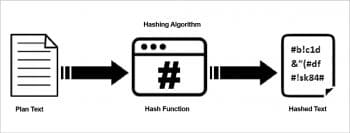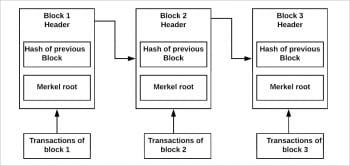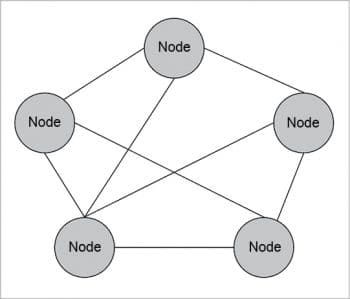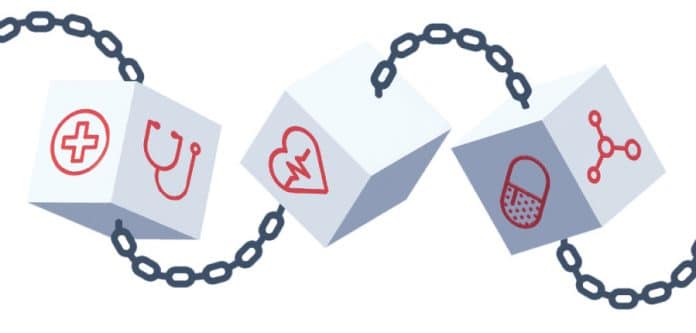Ever since the prices of bitcoin went sky rocketing, the computer world has been excited about the blockchain. Every day, new applications of the blockchain are being thought up, and the focus has shifted to using it in every conceivable human activity. This article explains how blockchain technology can be used in healthcare.
The blockchain is a distributed ledger to maintain records among users without relying on third parties. It exists as multiple copies spread over multiple nodes around the world. Everything is secure and each new block gets connected to the previous one. Also, the transactions stored in a block are immutable.
Let us suppose that we have ten participants in a blockchain network. Initially, everybody will be given an empty ledger. Now, if one person wants to carry out some transaction, i.e., store any new data on the blockchain, that person has to announce it to everybody else, so that every user can record that data on his/her personal ledger. Any data that gets on to the blockchain is immutable and distributed. After the ledger is full, it needs to be mined and connected to the main chain, after which the network (all ten participants) gets updates about the new block.
Hash function
To store the state of the blockchain, we use cryptographic hash functions. When any data is passed through this hash function, it generates a key to represent that data. This is a one-way function, which means you can go A->B but predicting B->A is almost impossible. Interestingly, we can represent the whole Internet as a single hash address.
For example, SHA256 (Secure Hash Algorithm that is used as the hash function) can store anything in 256 bits with almost no chance of collision. You can read more about this at https://blockgeeks.com/guides/what-is-hashing3.


Structure of a block
A block in the chain contains the block header, the hash pointer to the previous block header and the Merle root. The hash pointer contains the address of the previous block and the hash of the data of the previous block. The latter is what makes the blockchain amazingly reliable.
Merkle tree
In the Merkle tree, each non-leaf node is the hash of the values of its child nodes. By using Merkle trees, searching a transaction becomes really quick. Instead of linearly searching the transactions, the Merkle tree can decide faster if a transaction is contained in that block or not. Merkle trees are able to do this because of their structure.
Smart contracts
“Smart contracts work on the if-then promise,” to put it in Jeff Gazik’s words. As mentioned, the blockchain eliminates the need for a third party to settle transactions. While Bitcoin is like an alternative to regular money and just a distributed ledger, Ethereum has been developed as a platform that facilitates peer-to-peer contracts and applications though its own currency token. While Ethereum updates the network, it also sends some code known as the smart contract, which runs on node machines with the help of EVMs (Ethereum Virtual Machines).
Smart contracts serve the same purpose as the legal contracts in the real world. In typical cases that involve two parties, both sides have to agree on some terms to fulfil the agreement and only then sign the contract. Smart contracts do the same thing using algorithms. These contracts help to exchange services, buy things, etc, without a middleman in between. Everything in the market becomes transparent and efficient, and eliminates the chance of fraudulent activities.
In the real world, the supply chain is hampered by paper forms that have to be passed through many channels, exposing them to loss and fraud. If used, smart contracts can link up the whole supply chain by being executed at each step of the process. Also, when terms are fulfilled, the money can be transferred to the authorised party automatically, eliminating any fraudulent transactions. With the help of the blockchain, each step of the supply chain can become digitally accessible and transparent for all the parties on the network.

Problems with traditional databases
Traditional databases use a client-server architecture. A centralised administrator server collects data from clients and stores it at a central point. Anybody with sufficient access to the server can corrupt or destroy the data within. As a result, the moment you entrust your data to a regular database, you also become dependent on the human organisation in which the data resides. What if the company with terabytes of user data uses it for other purposes? Also, the central server can be brought down, leading to losses and a failure of the system. In a traditional database, a client can perform functions like create, read, update and delete.
Solutions using the blockchain
The core value of a blockchain is enabling a database to be directly shared across boundaries of trust, without requiring a central administrator. Blockchain consists of several decentralised nodes and all of them verify new transactions and update their ledgers. Pools of computing machines try solving a puzzle faster than others, after which the winner’s sequence of transactions gets added to the main chain. For solving each puzzle, the miner is rewarded with incentives in the form of tokens. After the addition of a new block on the blockchain, every node updates its ledger transaction sequence and reaches a consensus. This consensus guarantees the security of the network, making it difficult to tamper with.
Each newly added block is signed with a digital signature confirming that the majority of nodes have accepted it. This cryptographic hash digital signature maintains the integrity of data. The digital signature ensures data is unaltered and is thus reliable.
A second benefit is extreme fault tolerance because of the decentralised nature of the blockchain. The blockchain ensures that nodes that went down can always catch up on transactions they missed.
Issues with the healthcare supply chain
Supply chain management (SCM) can be defined as the integration of business processes from end users through manufacturers. It provides products, services and information, apart from adding value for customers.
In healthcare, supply chain management is a very long, complex and fragmented process. Companies are expanding their product portfolios to meet rapidly changing markets and shorter product life cycles. Emerging economies want more affordable products. Quality and compliance issues are rising because products are more complex and regulatory scrutiny is strict. Moreover, increasing drug recalls is also a huge issue for companies as it is hard to track the distribution. The many challenges that this sector faces can be read at http://thefintechtimes.com/future-healthcare-blockchain.
The whole supply process is very fragmented in a large country like India. Procuring raw materials, managing supplies and delivering goods to providers and patients is a complex process. Also, the information regarding medical products and services usually passes through many hands including manufacturers, agencies, insurance companies, hospitals and providers, giving rise to privacy concerns.
Hence, there’s an increased chance of information getting falsified somewhere in between. Any forged documents or tampered supplies can cost companies a large amount of money and pose a danger to patients’ health. Therefore, increasing the efficiency and transparency of the healthcare supply chain becomes critical for manufacturers.
Existing mechanisms in the healthcare supply chain
In a developing country like India, each clinic manages its own inventory and sales data. Here, the problem is that the store does not know what its future requirements might be. Nobody knows what problem the next patient will bring, or which epidemic will break out. Currently, everything operates based on the experience of the nurses and other staff. After this, an online purchase order (PO) is placed, which is an ID given to the order to be used for future references. This PO is included as an identity mark for any item that is part of this purchase order, bringing down processing time. For every further step, this PO is passed as a reference, thus maintaining a global reference number for that consignment.
First, after receiving the PO, the wholesaler checks the stock and if available, the status is set to be delivered within five days. If not, the wholesaler contacts the supplier and then the clinic has to wait longer for the supplies to arrive. This situation arises due to the delay in conveying information about the requirements, as the supply chain is not managed efficiently.
Second, the packaging and delivery of products is also done based on the order received through the PO. A delivery form has the contents of the order. This is paper-intensive work and any tampering can lead to a number of unwanted events; the obvious being money loss, spurious drugs and illegal trading.
Third, during the transportation of medicines, there is no check except for the driver of the truck. Such lack of oversight can be exploited to deliver counterfeit medicines. This can be prevented if medicines are tagged using bar codes, which can be stored on the blockchain for later inspection. The healthcare supply chain is so complex that no one can guarantee whether or not the medicine comes from the right manufacturer.

Also, when patients have unique requirements, calling for special products to be designed and delivered on an urgent basis, the logistical complexities ensure that it might take days for the product to even go into the design process.
Moreover, as reports, prescriptions and other patient related materials are issued by the staff members of the hospital, the documents can be easily lost or damaged. In other cases, the same patient can go to a number of doctors getting the same medicine prescribed repeatedly for the same health condition. Also, getting prescribed medicines from different chemists is fairly easy. This drug abuse takes many lives every year.
Most of the documents are always filled by the staff and not the doctor. Thus, these documents can be easily forged and tampered with, and are not reliable at all. This lack of trust is a big bottleneck when patients need to get reimbursements from insurance companies, quickly.
Advantages of integrating the blockchain in healthcare
Every time a product changes hands, the transaction could be documented electronically, creating a permanent history of it, from manufacturing to point of sale. Smart contracts at every stage can carry out transactions that needed a third party earlier, after the terms of the contracts are met. This could dramatically reduce time delays, added costs, and human error that plague the system today.
Some other advantages of using the blockchain in supply chain
Linking: Physical goods can be linked to bar codes, digital tags and serial numbers for better tracking, or can be linked to each other and used as needed.
Assigning: Verifying and assigning if a product needs some special treatment in transit—for example, if it needs refrigeration.
Tracking: Purchase orders, change orders, receipts, prescriptions and everything involved can be saved digitally and tracked on the blockchain. Also, the blockchain ensures immutability and better interpolation of data.
Recording: The quantity and transfer of assets like containers, pallets, etc, can be recorded as they move between places.
Sharing: Information sharing increases due to the transparency of the blockchain. As anyone on the network can see every other transaction happening, the data is reliable.
Also, this reliable data can be used for machine learning models with very high accuracy rates. This will help to predict future needs in a better way and can make the system significantly faster.
Integrating the supply chain into the blockchain
Blockchain can be applied to each stage of the healthcare supply chain. These include raw material supply, logistics, manufacturing, wholesale distribution and service providers, as well as electronic health records (EHR), validating patient data and even analysing a patient’s health records.
At the local level, the staff can maintain inventory as digital records, which will be put on the blockchain. By setting a minimum threshold through smart contracts, orders can be automatically placed for the needed supplies. All types of purchase orders (PO) and delivery orders (DO) can be maintained in a more flexible and accessible manner. Delivery orders can be pushed to logistics and the process will start. Also, we can tag shipments with bar codes and store them on the blockchain, against the delivery order form. This bar code can then be used to easily track the source of the package, leading to increased efficiency.
In hospitals, patients’ data is already stored electronically as EHR (electronic health records). But trust and transparency between organisations has always been an issue. By providing an immutable ledger with limited access to data, the blockchain can solve this problem. Data once recorded cannot be deleted and will always be there to look up. This helps doctors to have a deep insight into a patient’s health, which results in better diagnoses.
Prescription medication can be put on the blockchain against a customer’s account which will be visible to medical stores. The medical store, which is already assured of the legitimacy of the prescription, can inform the patient about the availability of medicines required. In this way, the blockchain solves problems such as forged prescriptions and double buying, and keeps a record of the final consumer of the medicine.
For medical giants, raw materials supply can be recorded and put onto a manufacturer’s blockchain network. The quantity of produced supplies and disposable goods can also be recorded digitally. Pending orders can be settled using time based escrow contracts, eliminating the need for a third party to approve the orders. Timestamps enable the blockchain to perform any transaction in a time sequential manner.

Also, the monetary value of reliable health records is very high for insurance companies. Access to the trusted data of the patient can help insurance companies decide on a better premium, which will increase the claim settling rates of the health insurance industry. The automation achieved can provide faster claim settlements, increasing the confidence of the customer towards insurance companies.
With the digitisation and automation achieved, the blockchain architecture will also fulfil the following objectives.
- Enhanced transparency, as end to end details are stored and accessible.
- Scalability: Any number of participants from any touchpoint can be added.
- Better security: The data, being digital and immutable with no centralised access, cannot be tampered with.
- Increased innovation: As data stored from every stage has been linked in a decentralised form, it can be used to predict supplies, thus removing loopholes and increasing innovation.
All these enhanced features of the blockchain maximise the efficiency and also strengthen the relationship across the supply chain.

Proof of identity and security
Every user on the blockchain has a private and a public key. Any time a user wants to do some transaction, he or she creates a digital signature using a private key along with the data to be sent. So this newly created digital signature will be sent along with the transaction to the receiver. The receiver will have the sender’s public key and using that, the user can be verified—if the digital signature was created using the private key behind the sender’s public key.
If anyone tries to tamper with the transaction in between, the sender’s public key will not be able to verify the new digital signature created using the sender’s private key as data has changed. This way the sender is provided security even if the data stored in form of encrypted hash is public.
To add people to the network, a POI (proof of identification) is needed. India has already implemented and adopted Aadhaar, an identification number. Services such as e-KYC can be used to authorise a new user onto the network. Aadhaar also directly connects a person to his/her bank account, which leads to less overhead for insurance companies.
The principle behind the blockchain is to make transactions public, but this is a big concern for health records. In our next article, we will explain how to encrypt data, when using blockchain for governance and also discuss the level controls of the data.













































































